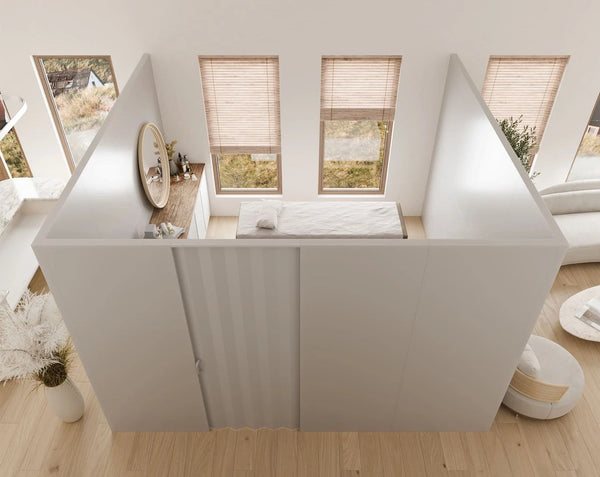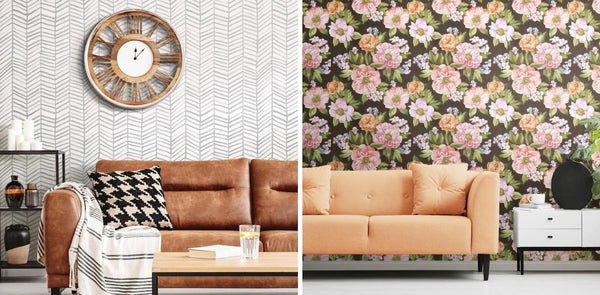What is FRP? Why Use FRP to Make Modular Walls?

Our temporary walls are a mix of paradoxes– they’re light and portable yet sturdy, they’re flexible yet long-lasting, and they’re DIY, yet they look absolutely clean and finished! What is it that allows them to be so robust and versatile?
Well, the short answer is FRP.
What exactly is FRP?
All our modular temporary wall kits are made of a material called fiberglass-reinforced plastic or FRP. FRP is a composite made of plastic resin and fiberglass strands – the combination of which is what makes it such a lightweight, strong and durable material.
While FRP has actually been around for a while, its popularity has skyrocketed only recently since its use in temporary walls and room dividers. It now boasts an impressive resume of features that are perfect for use not only in residential but also in commercial settings.

Why use FRP to make Modular Temporary Wall Kits
With a gazillion different materials available to make temporary walls and room dividers, we stand by FRP with unequivocal confidence. What makes FRP so special?
Lightweight and easy to install

One of the primary reasons to go with FRP is its lightweight nature. Even our largest wall panel size of 4’x4’ in 3” thickness can be lifted single-handedly and effortlessly by one person. This makes the whole installation process a breeze, even for those who aren’t experts.
FRP’s lightweight nature also means that the temporary walls made out of them don’t exert any unnecessary extra weight on the floor to increase the floor’s load.
Strength and durability

The combination of plastic and fiberglass strands makes FRP strong and durable. Its high strength-to-weight ratio ensures that our temporary walls and room dividers can withstand the wear and tear of daily life without compromising their structural integrity. After all, it would suck if the wall collapsed with a single collision of a fast-running kid, wouldn’t it?
The structural strength of FRP is also what makes our temporary walls so long-lasting, providing you reliable service without asking for constant maintenance or frequent replacement.
Moldability

FRP has a plastic base, which means it can be molded into any required shape. This property allows us to shape our modules like lego blocks with a simple connecting mechanism. It also lets us keep our modules hollow – they have a 3-dimensionality for extra sturdiness and strength, without having to be solid - which reduces their weight even further!
Resistance to moisture, mold and mildew
Most materials used to make partitions and room dividers are terribly sensitive to moisture – wood warps and rots and iron rusts and disintegrates. Not FRP. FRP has a non-porous surface and water-resistant properties, which means it’s free from the attacks of mold and mildew. Yes, this means it’s the perfect solution in areas with high moisture levels – kitchens, bathrooms and basements.
Aesthetic appearance and versatility
FRP comes with a clean, smooth and finished look that looks better, if not as good as plastered walls or drywalls. This means that our temporary walls blend seamlessly with your existing décor, without looking like add-ons or afterthoughts. Even though they’re 100% DIY, our modular wall kits when assembled, look like ‘real walls’!

Environmental advantages
Because of FRP’s durability and longevity, it doesn’t require frequent replacement, which ultimately reduces consumption of raw materials and energy. We make the most of these properties to make our temporary walls flexible, adaptable and reusable too. This means our walls can match with changing space needs unlike traditional drywall partitions that end up in the landfill with every small space change.
In an age where we cannot afford to overlook environmental impact, FRP offers some unbeatable advantages when compared to its traditional counterparts.
Easy to clean
FRP has a smooth, even surface which makes it harder for dust to settle on it. Even if it does get dirty with spills, foot marks, dirty hands, and whatnot, a quick wipe with a damp cloth and a mild detergent will keep it looking spick and span in no time! No need to worry about spending your weekends scrubbing these walls.

FAQs about FRP temporary walls
Here’s everything else you need to know about our FRP temporary walls and room dividers
1. Do FRP temporary walls have a smell?
Our FRP temporary walls should not have any smell when you receive them. The resin used in manufacturing FRP can have a slight smell after production, but it isn’t usually noticeable after packaging and shipping. If you do notice any smell, please reach out to us immediately and we will get you a replacement panel.
2. Is there any off-gassing phase?
FRP does have a minimal off-gassing during its curing process. However, since our temporary walls use fully-cured FRP, there’s no off-gassing phase. There could be some negligible remnant smell of the resin, but it disappears quickly after installation.
3. Are FRP temporary walls soundproof?
Our FRP panels do offer some degree of soundproofing – they have a Noise Reduction Coefficient of 0.5 which means they can block 50% of the sound waves that pass through them. However, most of the noise transfer occurs through the gap between the temporary wall and the ceiling. You can add additional soundproofing material to enhance acoustic performance.
4. Are FRP temporary walls fire-resistant?
Yes, our temporary walls have undergone rigorous fire testing and have been certified to meet the fire-resistance standards outlined in ASTM E-84 at Class C. This certification ensures that our walls successfully meet the stringent requirements for flame spread. Additionally, our walls are equipped with an ABS skeleton that includes specific additives for smoke reduction and fire retardancy, further enhancing their safety features. These additives contribute to minimizing smoke production and enhancing the fire resistance of our temporary walls.
5. Can FRP temporary walls be used in high-humidity conditions?
Yes, our FRP temporary walls are moisture resistant, which makes them a great option in damp spaces like kitchens, bathrooms and basements.
6. Can FRP temporary walls be used outdoors?
While our FRP temporary walls are durable and moisture-resistant, they aren’t designed specifically for outdoor use. UV exposure could reduce the lifespan or the panels, while constant wind pressures may not be great for the stability of a light-weight temporary wall. With that said, if you can properly secure the walls they can certainly be installed outdoors.
7. How do I clean FRP panels?
You can use a damp cloth with some mild detergent to clean your FRP temporary wall. Avoid using harsh or abrasive cleaners that could damage the surface and affect its longevity.
8. Are FRP temporary walls scratch-resistant?
While our FRP temporary walls are generally scratch-resistant, they can be susceptible to gouges and scratches if subjected to sharp or heavy objects. TLC is the best way to ensure these flexible companions stick with you for years.
9. Can FRP walls be painted over or customized?
Because our FRP walls have a smooth, polished surface, it would be difficult for paint to adhere to it. A paint job would be a tedious process involving sanding the entire surface, cleaning it and priming it with an acrylic or epoxy-based primer. Instead, we recommend using peel-and-stick wallpapers that come in a variety of colors, patterns and designs.

Our FRP temporary walls are customizable too. From making a gallery wall, accent wall, plant wall or art wall to hanging floating shelves and light fixtures, the possibilities are endless!

10. How long do FRP temporary walls last?
Because of their moisture and corrosion resistance, our temporary walls can last for many years, depending on factors like usage and maintenance. Yes, with a bit of TLC, FRP walls can continue to provide flexible space transformations for even decades.
Get your DIY FRP temporary wall today!
We have a wide-range of modular DIY temporary walls made from FRP. They're 100% flexible and can be assembled and taken apart without any special expertise in less than a couple of hours, with nothing but a screwdriver! Get in touch with us, and we’ll help you find the best room division solution for your space.

